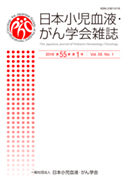Volume 58, Issue 1
Displaying 1-13 of 13 articles from this issue
- |<
- <
- 1
- >
- >|
The 61st Annual Meeting of the Japanese Society of Pediatric Hematology / Oncology
-
2021Volume 58Issue 1 Pages 1-5
Published: 2021
Released on J-STAGE: June 08, 2021
Download PDF (7060K)
Original Article
-
2021Volume 58Issue 1 Pages 6-11
Published: 2021
Released on J-STAGE: June 08, 2021
Download PDF (1071K) -
2021Volume 58Issue 1 Pages 12-18
Published: 2021
Released on J-STAGE: June 08, 2021
Download PDF (963K) -
2021Volume 58Issue 1 Pages 19-25
Published: 2021
Released on J-STAGE: June 08, 2021
Download PDF (840K)
Case Report
-
2021Volume 58Issue 1 Pages 26-30
Published: 2021
Released on J-STAGE: June 08, 2021
Download PDF (1699K) -
2021Volume 58Issue 1 Pages 31-34
Published: 2021
Released on J-STAGE: June 08, 2021
Download PDF (1792K) -
2021Volume 58Issue 1 Pages 35-39
Published: 2021
Released on J-STAGE: June 08, 2021
Download PDF (1256K) -
2021Volume 58Issue 1 Pages 40-44
Published: 2021
Released on J-STAGE: June 08, 2021
Download PDF (4240K) -
2021Volume 58Issue 1 Pages 45-49
Published: 2021
Released on J-STAGE: June 08, 2021
Download PDF (3039K) -
2021Volume 58Issue 1 Pages 50-54
Published: 2021
Released on J-STAGE: June 08, 2021
Download PDF (7460K) -
2021Volume 58Issue 1 Pages 55-59
Published: 2021
Released on J-STAGE: June 08, 2021
Download PDF (1663K)
Report
-
2021Volume 58Issue 1 Pages 60-66
Published: 2021
Released on J-STAGE: June 08, 2021
Download PDF (11234K) -
2021Volume 58Issue 1 Pages 67-87
Published: 2021
Released on J-STAGE: June 08, 2021
Download PDF (51455K)
- |<
- <
- 1
- >
- >|
